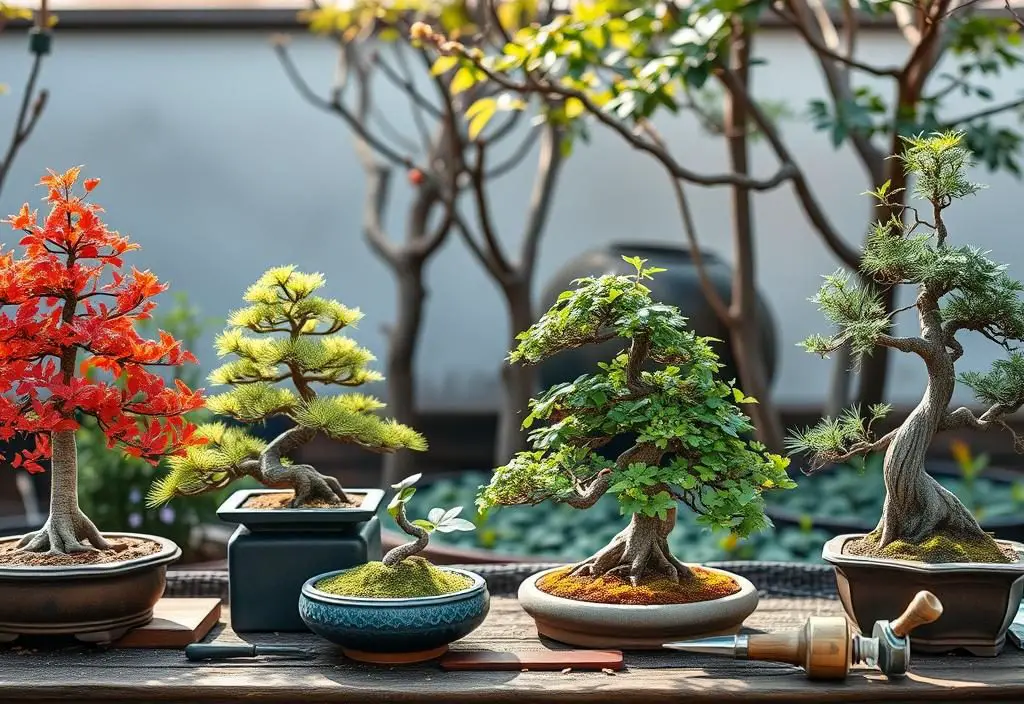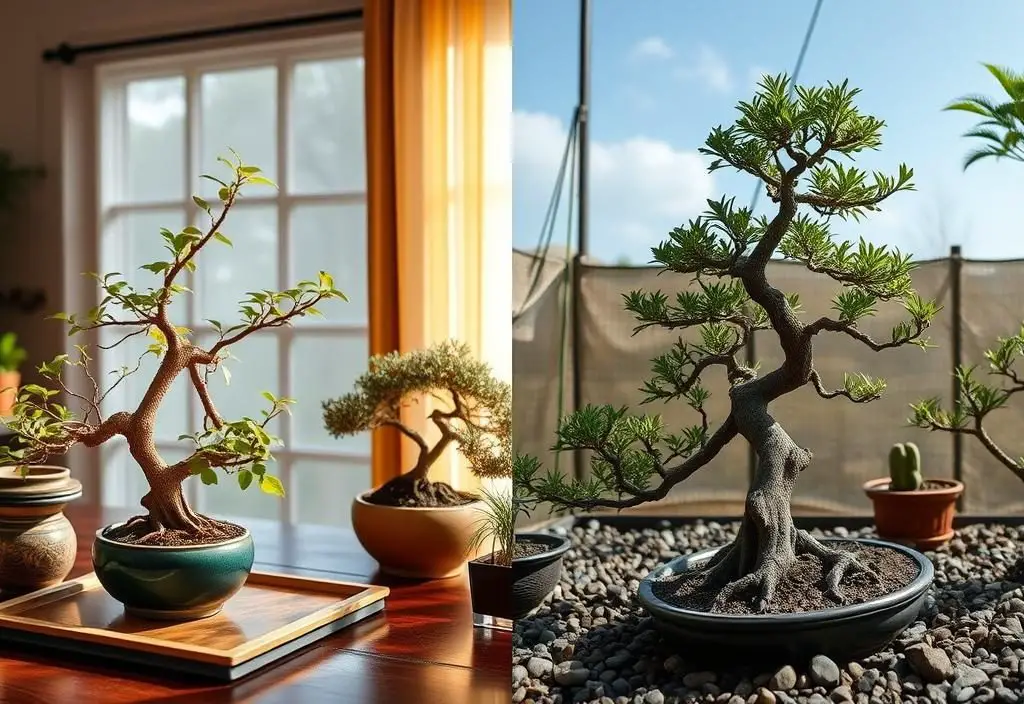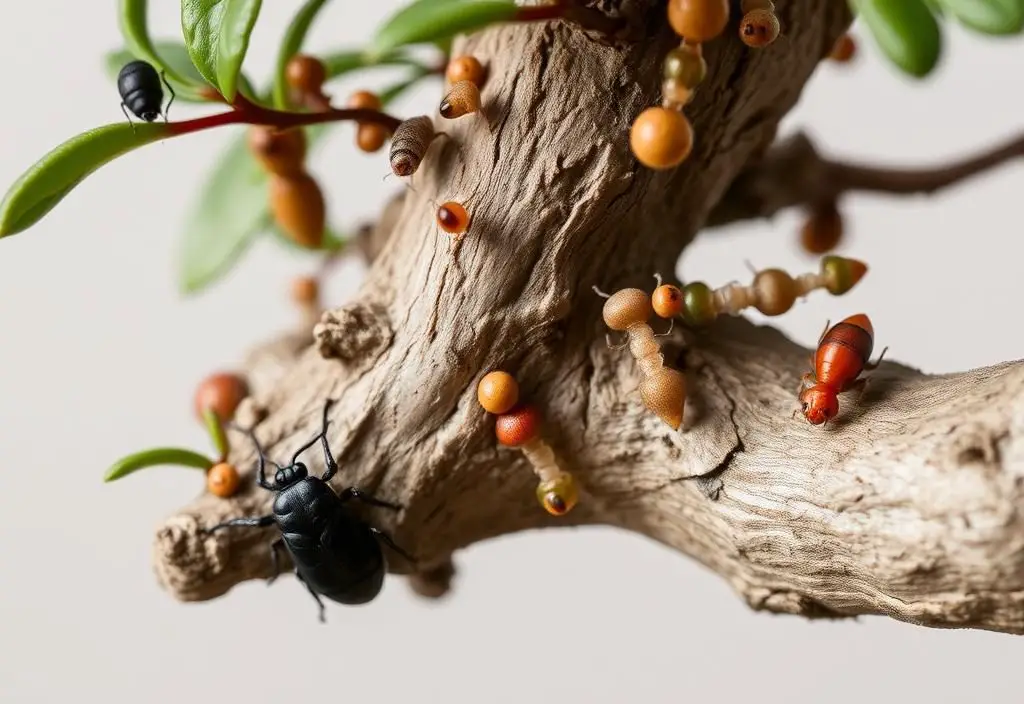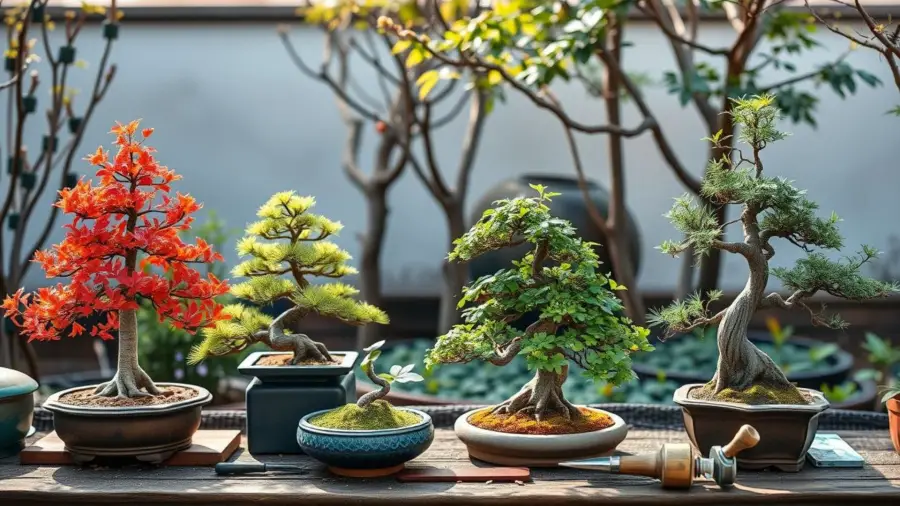Starting with bonsai trees is exciting. They are small, yet beautifully crafted. If you’re new to bonsai, picking the right top 5 bonsai trees for beginners is key.
Bonsai trees are great for indoor gardening. They need little care and can thrive indoors. This makes them perfect for those with small spaces or who prefer indoor plants.

In this guide, we’ll explore the top 5 bonsai trees for beginners. They are chosen for their easy care and indoor adaptability. Let’s dive into the world of bonsai and find your first tree!
Understanding the Art of Bonsai: A Beginner’s Guide
The world of bonsai is fascinating, showing the ancient Japanese art of making trees small. It’s a hobby that draws people from all over. For beginners, learning about bonsai’s history and culture is key.
The History and Cultural Significance of Bonsai
Bonsai started in ancient China, linked to Taoist and Buddhist beliefs. It moved to Japan, where it grew and became a big part of Japanese culture. Bonsai trees are more than just plants; they show harmony, patience, and the balance between nature and humans.
Basic Principles of Bonsai Cultivation
- Careful pruning and wiring to shape the tree’s growth
- Strategic root management to maintain a small, balanced root system
- Precise watering and feeding schedules to support the tree’s health
- Selecting the right container and soil mix to mimic the tree’s natural environment
Why Start with Beginner-Friendly Species
Starting with easy-to-grow species is smart for beginners. Easy bonsai species to grow, like ficus, Chinese elm, and jade plant, are great for newbies. These indoor bonsai plant care options help you learn and grow. By following a bonsai care guide for these trees, you’ll become a skilled bonsai lover.
“Bonsai is not just a plant, it’s a living piece of art that requires patience, dedication, and a deep appreciation for the natural world.”
Essential Tools and Materials for Starting Your Bonsai Journey
Starting your bonsai journey is exciting. You’ll need the right tools and materials for your trees to grow well. Whether you’re in Bangladesh or anywhere else, here’s what you need to begin.
Choosing the Right Bonsai Pots
The pot you choose is very important. Look for shallow, unglazed pots that let roots breathe. The pot should be just a bit bigger than the roots to help them grow right.
Essential Bonsai Tools
- High-quality pruning shears: Get sharp scissors made for bonsai trimming.
- Bonsai wire: This wire helps shape the tree’s branches.
- Concave cutters: Use these for clean cuts on thick branches.
- Root hook: A small tool for untangling and positioning roots.
- Watering can: Choose a can with a long spout to water without harming leaves.
Selecting the Best Bonsai Fertilizer
Good nutrition is vital for your bonsai’s health. Find a balanced fertilizer that’s good for beginners. Look for slow-release options to use every few weeks when your tree is growing.
With the right tools, pots, and buying bonsai tools in Bangladesh, you’re ready to start. Your bonsai will bring joy and peace to your home. The journey is as important as the end result.
Top 5 Bonsai Trees for Beginners
Starting your bonsai journey can be thrilling and a bit scary. But, picking the right tree makes it easier and more fun. Let’s look at the top 5 bonsai trees great for beginners.
Ficus Bonsai: The Perfect Indoor Starter
The ficus bonsai is perfect for indoor lovers. These trees are tough and do well in a home setting. They have beautiful leaves and are easy to care for, making them great for beginners.
Chinese Elm: Hardy and Forgiving
The Chinese elm bonsai is loved by beginners. It’s adaptable and can handle different light and a little neglect. Its small leaves and branches make it look beautiful.
Jade Plant: Succulent Beauty
The jade bonsai is perfect for succulent fans. It has thick leaves and a small tree shape. They need little water and occasional pruning, making them easy to care for.
Japanese Maple: Seasonal Wonder
The Japanese maple bonsai is a favorite for beginners. It has amazing leaves that change colors with the seasons. While it needs a bit more care, the beauty it brings is worth it.
Azalea: Flowering Favorite
The azalea bonsai is great for those who love flowers. It has beautiful blooms in many colors. They are easy to care for, making them perfect for newbies.
These top 5 bonsai trees are great for beginners. By choosing one that fits your style and skill, you can start a rewarding journey. You’ll get to create your own mini masterpieces.
Creating the Perfect Environment for Your Bonsai
To grow a thriving bonsai, you need the right conditions. This is true whether it’s indoors or outdoors. In Bangladesh, knowing the climate and adjusting your care is key to success.
Choosing between indoor vs outdoor bonsai care depends on light, temperature, and humidity. Bonsai tree types for hot weather need different care than those for cooler places. Tailor your care to your bonsai’s specific needs for the best results.
Lighting Needs
- Give your bonsai plenty of sunlight, either natural or artificial.
- Change the light based on the tree type – some like shade, others sun.
Temperature Regulation
- Keep the temperature between 65°F and 85°F (18°C to 29°C).
- Shield your bonsai from extreme temperatures.
- Use a greenhouse or indoor space for the perfect temperature.
Humidity Considerations
Bonsai trees like humidity of 50-70%. To increase humidity, you can:
- Mist the leaves often
- Put the bonsai on a tray with pebbles and water
- Use a humidifier nearby
By understanding and meeting the climate requirements for bonsai in Bangladesh, you can create the best environment. This is true for both indoor and outdoor bonsai care.

“Bonsai is an art that requires patience, dedication, and a deep understanding of the needs of your miniature tree.”
Soil Requirements and Potting Techniques
Finding the right soil mix is key to a perfect bonsai. The best soil mix for bonsai trees balances drainage, nutrients, and pH levels. Knowing the bonsai soil pH requirements is vital for your bonsai’s health.
Choosing the Right Soil Mix
The bonsai soil mix for beginners should mix organic and inorganic materials. This includes akadama, pumice, and premium potting soil. It ensures good drainage and nutrients for growth.
- Akadama: Helps with drainage and water retention
- Pumice: Improves aeration and prevents soil compaction
- Potting soil: Supplies essential nutrients for healthy root development
Understanding Drainage Needs
Good drainage is crucial for your bonsai’s health. Too much water can cause root rot, while too little can stress the plant. The soil mix should drain well but still hold enough moisture.
Proper Potting Methods
Potting your bonsai right is important. Remove the plant from its pot, loosen the roots, and put it in a new container. Fill the space with your chosen soil mix, making sure the soil level is below the pot rim for water absorption.
| Soil Component | Percentage | Benefit |
|---|---|---|
| Akadama | 40-50% | Drainage, water retention |
| Pumice | 30-40% | Aeration, prevent compaction |
| Potting Soil | 10-20% | Nutrient supply |
Choosing the right soil mix and potting techniques is essential. It sets the stage for a thriving bonsai journey.
Watering Guidelines for Beginner Bonsai Trees
Keeping the right moisture level is key for your bonsai plants’ health. As a beginner, knowing how to water is crucial. It helps your miniature trees thrive indoors. Here are the essential watering tips for your bonsai collection.
Watering Frequency
How often to water bonsai plants depends on several things. These include the plant’s species, pot size, and environment. Generally, check the soil daily and water when the top inch is dry to the touch. Don’t let the soil dry out completely, as it can harm the plant.
Watering Technique
When watering, use a gentle stream and avoid waterlogging the soil. Pour water until it drains from the pot’s bottom, then stop. This helps the roots get the right moisture without harming the plant. Avoid overhead watering to prevent fungal growth and leaf discoloration.
Fertilizing Considerations
Fertilizing is also key for your bonsai’s health and growth. Use a balanced, water-soluble fertilizer and apply it every two to four weeks during the growing season. In the dormant winter months, reduce or stop fertilizing to avoid overstimulating the plant.
By following these guidelines and a balanced fertilization routine, you can ensure your bonsai plants stay healthy and thrive indoors. Remember, observe your plants closely and adjust your care as needed.
Pruning and Shaping Basics for Newcomers
Bonsai lovers know that pruning is key to keeping these tiny trees in shape. Whether you’re new or have been growing bonsai for years, learning the basics of pruning is essential. We’ll cover the basics of bonsai pruning and shaping. This will help you turn your bonsai into a stunning piece of art.
Basic Pruning Techniques
Pruning is the heart of bonsai care, helping you control your tree’s growth and shape. Start by picking out the parts that need cutting, focusing on dead or damaged branches. Use sharp, clean shears for clean cuts. This helps your bonsai heal well.
Always cut above an outward-facing bud or branch. This guides the growth in the right direction.
Wire Training Methods
- Wire training is a powerful tool in the bonsai artist’s arsenal, allowing you to gently bend and shape the branches into your desired form.
- When applying wire, be sure to wrap it snugly but not too tightly, as this can damage the delicate bark and cambium layer.
- Choose the right wire thickness for the size and strength of your bonsai branches, and plan to remove the wire before it starts cutting into the bark.
Maintaining Tree Shape
Regular and careful pruning keeps your bonsai in perfect shape. Create a pruning schedule that fits your bonsai’s growth rate and needs. Be patient and choose your cuts wisely. This way, you’ll learn to shape your bonsai into a beautiful piece of art.
| Tool | Purpose |
|---|---|
| Bonsai pruning shears | Precise trimming of branches and foliage |
| Concave cutters | Removing larger branches with a clean, flush cut |
| Bonsai wire | Shaping and positioning branches into desired forms |
| Aluminum or copper wire | Ideal for training and shaping bonsai |
“The secret to a perfect bonsai lies in the hands of a patient and observant gardener.”
Common Challenges and Solutions in Bonsai Care
As a bonsai enthusiast, I’ve found that caring for these small trees can be tricky. Issues like diseases and pests are common. But, with the right knowledge, you can keep your bonsai healthy and thriving.
One big problem is root rot, caused by too much water or bad soil. To avoid this, use a good soil mix and water wisely. Check the soil often and adjust your watering to keep your bonsai safe.
- Look for signs of root rot like yellow leaves and mushy roots.
- Use a bonsai potting mix with ingredients like akadama and pumice.
- Water carefully to avoid too much water, letting the soil dry a bit between waterings.
Another big challenge is dealing with pests. Pests like spider mites and aphids can harm your bonsai. To protect bonsai trees from pests, check your plants often and act fast to stop infestations.
- Watch for pests like webbing and unusual growths on your bonsai.
- Use insecticidal soap or neem oil to get rid of pests safely.
- Keep your bonsai tools and workspace clean and disinfected.
Knowing about common bonsai tree pests and solutions helps you keep your bonsai healthy. A little effort and care can make your bonsai beautiful and long-lasting.

“The secret of growing healthy bonsai lies in the care and attention you give to them, not in their size.”
Seasonal Care Tips for Your First Bonsai
As a beginner bonsai enthusiast, it’s key to know how to care for your tree all year. By following seasonal care routines, you can keep your bonsai healthy and long-lived. Let’s look at the main care tips for each season.
Spring Care Routines
In spring, your bonsai is ready to grow after a winter sleep. It’s time to trim dead branches, repot if needed, and give it new soil. Also, remember to water it more often since it’s growing fast.
Summer Protection Methods
Summer can be tough for bonsai, with heat and dryness. Make sure it gets enough shade, either in a shaded spot or with a shade cloth. Also, keep the soil moist to prevent drying out.
Fall Preparation Steps
In fall, your bonsai starts to get ready for winter. Cut back on watering and fertilizing to help it sleep. Prune any stray branches and make sure the roots are snug in the pot before winter.
Winter Protection Strategies
Winter needs special care for your bonsai. Move it to a safe place, like a greenhouse, and water less to avoid root rot. Watch for signs of stress or pests and be ready to protect it more if needed.
FAQ
What are the top 5 bonsai trees for beginners?
For beginners, the best bonsai trees are the Ficus, Chinese Elm, Jade Plant, Japanese Maple, and Azalea. These are easy to care for and grow well indoors. They’re perfect for those new to bonsai.
How do I choose the right bonsai tree pot?
Choose a pot that fits your tree’s size and shape. Make sure it has drainage holes. The pot should also look good with your bonsai.
What is the best bonsai soil mix for beginners?
Beginners should use a mix that drains well and is rich in nutrients. A blend of akadama, pumice, and organic matter is best. It helps your bonsai grow strong and healthy.
How often should I fertilize my bonsai tree?
Fertilize your bonsai every 2-4 weeks in spring and summer. Use a slow-release bonsai fertilizer. In fall and winter, fertilize less often.
How do I prune and shape my bonsai tree?
Start with basic pruning to shape your bonsai. Remove unwanted growth and guide branches with wire training. This helps your bonsai look its best.
How can I protect my bonsai tree from pests and diseases?
Check your bonsai often for pests and diseases. Use organic treatments like insecticidal soap or neem oil. Keep it healthy with good care and conditions.
Can bonsai trees grow indoors?
Yes, many bonsai trees do well indoors. They need the right light, temperature, and humidity. Ficus, Chinese Elm, and Jade Plant are good choices for indoors.
How often should I water my bonsai tree?
Water your bonsai when the top soil feels dry. Check daily and avoid letting the soil dry out completely. Don’t let it stay wet for too long.
How do I repot my bonsai tree?
Repot your bonsai every 2-3 years. Gently remove it, trim the roots, and put it in a slightly bigger pot with fresh soil. Do this when it’s actively growing.
How long do bonsai trees live?
With good care, bonsai trees can live a long time. They can live 50-100 years or more. The Ficus, Chinese Elm, and Japanese Maple are known for their longevity.
